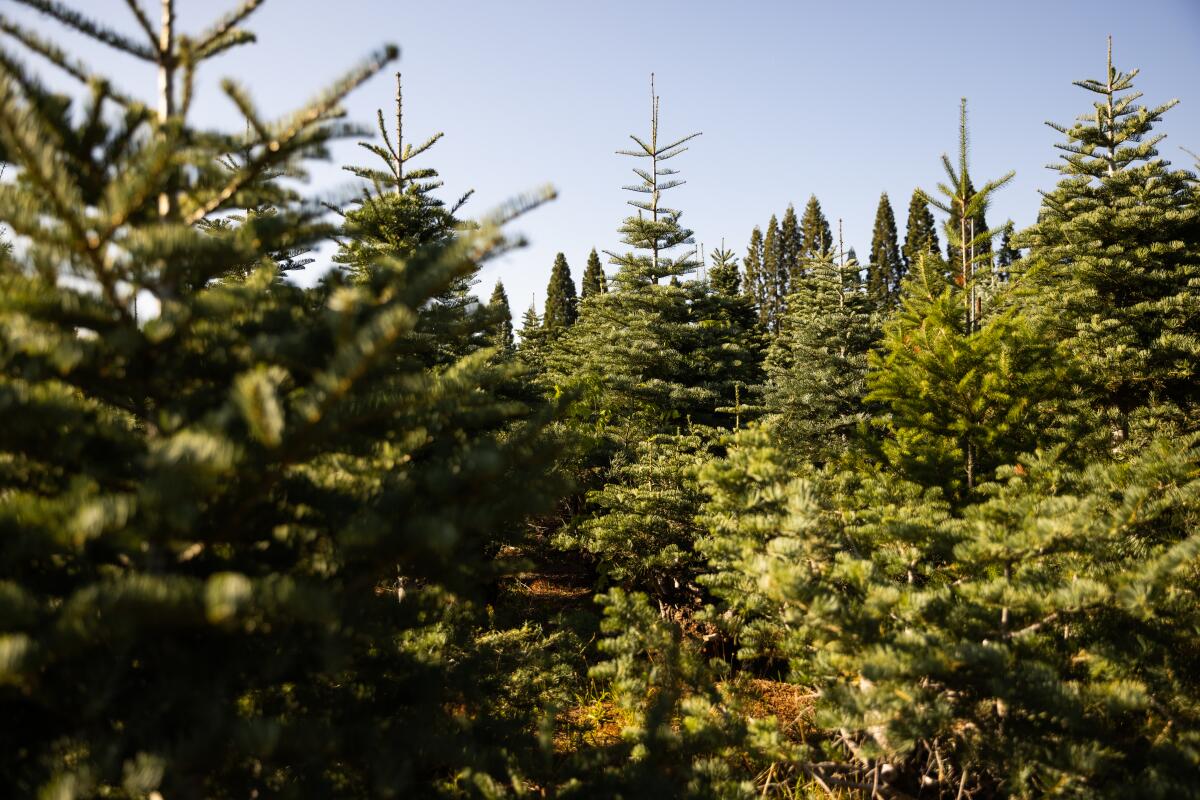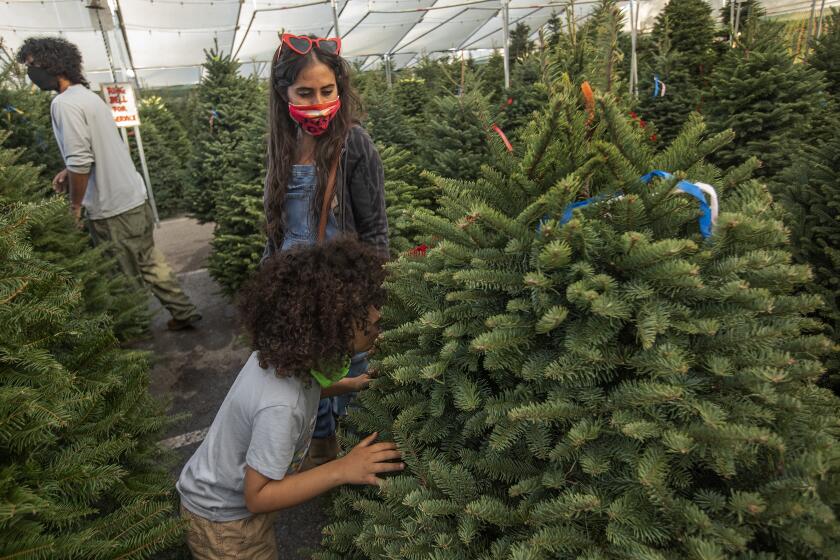The holidays don’t have to be stressful. That’s what a potted Christmas tree taught my family

- Share via
As my family’s director of seasonal merriment, I bear a heavy load each year in the name of ritual togetherness. All the work can bring cascading feelings of excess and overwhelm. But we’ve found one way to simplify our holidays: We keep the same Christmas tree in a pot, like a houseplant.
I was not always thrilled with this idea. When my husband and I moved more than a decade ago to Oregon, the country’s top producer of Christmas trees, I still had dreams of yearly trips to the Deschutes National Forest in search of the perfect tree, after getting a $5 government permit to cut our own in the wild. Surrounded by snow and fueled by hot chocolate, we would hand-pick a noble fir with serenely proportioned branches and a scent that put candles to shame. That first year, it seemed like every pillow, towel or ornament display presented a smug image of a station wagon with its evergreen haul strapped to the roof. I yearned for a holiday so iconic.
Instead, I soon discovered I had married a tree whisperer with his own plans for our annual display. When December rolled around, my new husband pointed to a 4½-foot sequoia in a pot in the yard and said he would schlepp it into the house every year for the rest of our lives.
If you’re anything like me — with a psyche deeply informed by ’80s family sitcoms and general anxiety about getting family life right — you’ll understand my initial skepticism. The plant was at least two feet shorter than the average Christmas tree, almost bushlike. It had a crooked trunk and sparse branches that even well-placed ornaments couldn’t remedy.
But my husband insisted, muttering about the “tree graveyards” (tree lots) on the sides of roads all around us. So I humored him, hung ornaments and schemed to buy a new tree next time. The year thereafter, once he had trimmed the sequoia’s root bulb (a common practice for potted houseplants), it grew back resembling a Christmas tree a little more — deep sage, with a subtle scent. Before long, its prickly pads stopped bothering me, and it began to fill out. I saw how happy it made my husband to watch it over time — one more way I see him investing in the long game of our shared life.
Now we trim and shape the same tree every year, and it has shaped us back — helping to remake our holidays into a more calming ritual. First, having a live tree provides natural timing to bookend decorating: We bring the tree inside on Dec. 6 (St. Nicholas Day) and return it to our yard the day after Christmas, so it can survive its brief stay inside. It was too small to accommodate all the ornaments we had each inherited, so we went through them one-by-one and decided purposefully what to keep and what to donate. That helped us set boundaries for ornament gifting: We let it be known to family and friends that while there will always be room at the inn (our house), our tree was full.
These simplifications opened up a world of activities to avoid. We weighed which traditions to pursue and — more often — which to say “no thanks” to. No to the omnipresent red, a color that agitated me. No to nomadic elves on shelves, no to visits to Santa’s knee that our kids didn’t enjoy, no to the tyranny of matching wrapping paper.
How to pick out and set up a live Christmas tree and keep it merry and bright through the new year.
We put our tree in a plastic pot so one person could manage the weight. Our Christmas became something we could physically carry. We watered it, rotated it in the sunny months and visited it whenever we wanted. We watched as our sons, inspired by tending to the sequoia, became more vigilant about caring for all trees in the world.
By replacing the tradition of cutting down a tree with a new tradition of growing one, we learned to cut back on seasonal excess — on forcing ourselves through activities that felt obligatory for family life but actually disrupted our season.
Those decisions will look different for each family, and a potted tree isn’t an environmental imperative. Tree-recycling programs are cropping up around the country, and environmental groups herald cut trees as a way for consumers to support forest management. Even the Nature Conservancy recommends buying a cut tree over a plastic one.
The point is that prescribed holiday rituals seldom carry the emotional satisfaction of those created personally over time. In our house, Christmas has become a hope that we keep alive year-round. We’ve found ourselves transformed by the act of caring for our sequoia. What are the holidays if not a chance to choose the rituals that show we care — and remind us that we know how to?
Eventually, the season ends, but not sadly. We box up the ornaments, unravel three short light strands and carry the tree out to the yard. There it will grow a little, weather the elements and respond to my husband’s seasonal pruning, until we welcome it back next year in a recognizable shape — one part what we have envisioned, one part left to its wild self.
Emily Grosvenor is the author of the forthcoming book “Find Yourself at Home: A Conscious Approach to Shaping Your Space and Your Life.”
More to Read
A cure for the common opinion
Get thought-provoking perspectives with our weekly newsletter.
You may occasionally receive promotional content from the Los Angeles Times.










